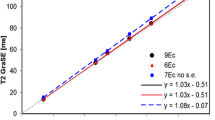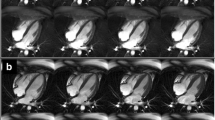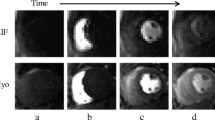Abstract
Background: High resolution magnetic resonance (MR) imaging of the coronary artery wall in vivo has been limited by the cardiac and respiratory motion, flow artifacts as well as the relatively small size of the coronary arteries. We sought to validate in vivo black blood MR imaging of the coronary artery wall using a double inversion recovery fast spin echo MR imaging sequence with limited breath-holding and cardiac gating for suppression of motion artifacts by comparison with ex vivo MR imaging. Methods: Yorkshire albino swine (n = 6) were used in this study and coronary lesions were induced with balloon angioplasty. Four weeks after balloon injury of the coronary arteries MR imaging of the coronary artery lesions was performed. High resolution in vivo and ex vivo images of the coronary artery wall and lesions were obtained using a double inversion recovery fast spin echo sequence in a 1.5 T MR system. There was a statistically significant agreement (p < 0.0001) between measurements of vessel wall area (r = 0.87, slope = 0.87) and maximal wall thickness (r = 0.84, slope = 0.88) from in vivo and ex vivo MR images of the coronary arteries. The mean differences between in vivo and ex vivo measurements were 0.56 ± 1.98 mm2 for vessel wall area and 0.02 ± 0.36 mm for maximal wall thickness. Conclusions: Using breath-holding and cardiac gating, it is possible to perform high resolution MR imaging of the coronary artery wall in vivo with good suppression of motion artifacts with a double inversion recovery fast spin echo black blood imaging sequence.
Similar content being viewed by others
References
Yuan C, Beach KW, Smith LH, Jr., Hatsukami TS. Measurement of atherosclerotic carotid plaque size in vivo using high resolution magnetic resonance imaging. Circulation 1998; 98: 2666-2671.
Worthley SG, Helft G, Fuster V, et al. High resolution ex vivo magnetic resonance imaging of in situ coronary and aortic atherosclerotic plaque in a porcine model. Atherosclerosis. In press.
Toussaint JF, LaMuraglia GM, Southern JF, Fuster V, Kantor HL. Magnetic resonance images lipid, fibrous, calcified, hemorrhagic, and thrombotic components of human atherosclerosis in vivo. Circulation 1996; 94: 932-938.
Skinner MP, Yuan C, Mitsumori L, et al. Serial magnetic resonance imaging of experimental atherosclerosis detects lesion fine structure, progression and complications in vivo. Nat Med 1995; 1: 69-73.
McConnell MV, Aikawa M, Maier SE, et al. MRI of rabbit atherosclerosis in response to dietary cholesterol lowering. Arterioscler Thromb Vasc Biol 1999; 19: 1956-1959.
Fayad ZA, Fallon JT, Shinnar M, et al. Noninvasive in vivo high-resolution magnetic resonance imaging of atherosclerotic lesions in genetically engineered mice. Circulation 1998; 98: 1541-1547.
McConnell MV, Khasgiwala VC, Savord BJ, et al. Prospective adaptive navigator correction for breath-hold MR coronary angiography. Magn Reson Med 1997; 37: 148-152.
Botnar RM, Stuber M, Danias PG, et al. Improved coronary artery definition with T2-weighted, free-breathing, three-dimensional coronary MRA. Circulation 1999; 99: 3139-3148.
Manning WJ, Li W, Edelman RR. A preliminary report comparing magnetic resonance coronary angiography with conventional angiography. N Engl J Med 1993; 328: 828-832.
Edelman RR, Chien D, Kim D. Fast selective black blood MR imaging. Radiology 1991; 181: 655-660.
Campos S, Martinez, Sanjuan V, et al. New black blood pulse sequence for studies of the heart. Int J Card Imaging 1999; 15: 175-183.
Fuster V, Badmion L, Badmion JJ, et al. The porcine model for the understanding of thrombogenesis and atherogenesis. Mayo Clinic Proceedings 1991; 66: 818-831.
Gallo R, Padurean A, Toschi V, et al. Prolonged thrombin inhibition reduces restenosis after balloon angioplasty in porcine coronary arteries. Circulation 1998; 97: 581-588.
Bland JM, Altman DG. Statistical methods for assessing agreement between two methods of clinical measurement. Lancet 1986; 1: 307-310.
Author information
Authors and Affiliations
Rights and permissions
About this article
Cite this article
Worthley, S.G., Helft, G., Fayad, Z.A. et al. Cardiac gated breath-hold black blood MRI of the coronary artery wall: An in vivo and ex vivo comparison. Int J Cardiovasc Imaging 17, 195–201 (2001). https://doi.org/10.1023/A:1010688122184
Issue Date:
DOI: https://doi.org/10.1023/A:1010688122184




